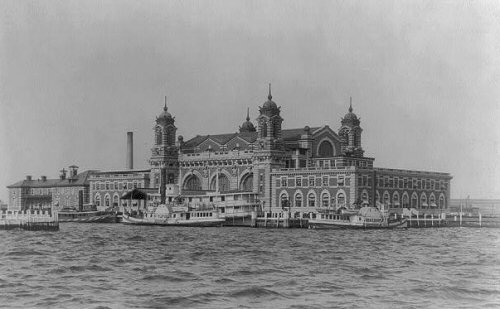Ellis Island
- See Emma's translation or her father's letter to relatives just after arriving in the USA.
- Zie de brief van Roelof Pieters Ruiter naar zijn familieleden na zijn emigratie naar de VS.

While there were many reasons to emigrate to America, no reason could be found for what would occur only five years after the Ellis Island Immigration Station opened. During the evening of June 14, 1897, a fire on Ellis Island, burned the immigration station completely to the ground. Although no lives were lost, many years of Federal and State immigration records dating back to 1855 burned along with the pine buildings that failed to protect them.
The United States Treasury quickly ordered the immigration facility be replaced under one very important condition. All future structures built on Ellis Island had to be fireproof. On December 17, 1900, the new Main Building was opened and 2,251 immigrants were received that day.
While most immigrants entered the United States through New York Harbor (the most popular destination of steamship companies), others sailed into many ports such as Boston, Philadelphia, Baltimore, San Francisco and Savannah, Miami, and New Orleans. The great steamship companies like White Star, Red Star, Cunard and Hamburg-America played a significant role in the history of Ellis Island and immigration in general.
First and second class passengers who arrived in New York Harbor were not required to undergo the inspection process at Ellis Island. Instead, these passengers underwent a cursory inspection aboard ship; the theory being that if a person could afford to purchase a first or second class ticket, they were less likely to become a public charge in America due to medical or legal reasons. The Federal government felt that these more affluent passengers would not end up in institutions, hospitals or become a burden to the state.
However, first and second class passengers were sent to Ellis Island for further inspection if they were sick or had legal problems.
This scenario was far different for 'steerage' or third class passengers. These immigrants traveled in crowded and often unsanitary conditions near the bottom of steamships with few amenities, often spending up to two weeks seasick in their bunks during rough Atlantic Ocean crossings. Upon arrival in New York City, ships would dock at the Hudson or East River piers.
First and second class passengers would disembark, pass through Customs at the piers and were free to enter the United States. The steerage and third class passengers were transported from the pier by ferry or barge to Ellis Island where everyone would undergo a medical and legal inspection.
If the immigrant's papers were in order and they were in reasonably good health, the Ellis Island inspection process would last approximately three to five hours. The inspections took place in the Registry Room (or Great Hall), where doctors would briefly scan every immigrant for obvious physical ailments.
Doctors at Ellis Island soon became very adept at conducting these 'six second physicals.' By 1916, it was said that a doctor could identify numerous medical conditions (ranging from anemia to goiters to varicose veins) just by glancing at an immigrant. The ship's manifest log (that had been filled out back at the port of embarkation) contained the immigrant's name and his/her answers to twenty-nine questions.
This document was used by the legal inspectors at Ellis Island to cross examine the immigrant during the legal (or primary) inspection. The two agencies responsible for processing immigrants at Ellis Island were the United States Public Health Service and the Bureau of Immigration (later known as the Immigration and Naturalization Service - INS). On March 1, 2003, the Immigration and Naturalization Service was re-structured and included into 3 separate bureaus as part of the U.S. Department of Homeland Security.
 |
Foutje gevonden? Opmerkingen? Meld het via het reactieformulier! |
 vorige vorige |
volgende  |